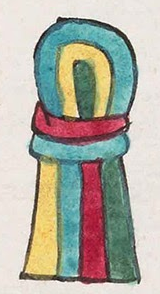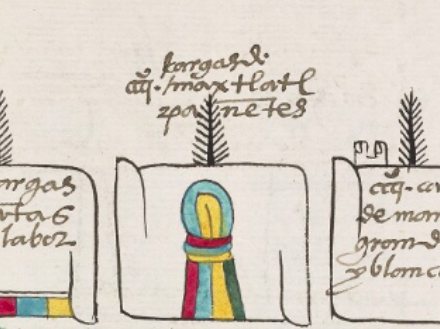maxtlatl (Mdz54r)
This loincloth, a simplex glyph found in the tributes section of in the Codex Mendoza, provides for an interesting comparison with other loincloths in this collection, such as shown in the place name Amaxtlan. The loincloth in the compound glyph for Amaxtlan is white with black horizontal lines forming the design at the bottom of the cloth strips. This simplex glyph has no designs at the bottom, but it involves combined strips of cloth in multiple colors--yellow, turquoise, red and green, going from left to right. Loincloths were worn by men, in front of their genitals. A waist belt held them on. Differences in designs of maxtlatl probably related to social status (loincloths for the lower social strata were made from maguey fiber according to Henry B. Nicholson and Eloise Quiñones Keber in the Art of Aztec Mexico, 1983, p. 183), and perhaps also ethnicity and/or occupation. On some occasions, symbolic loincloths were carried in religious processions, such as those described by Kay Read, Time and Sacrifice in the Aztec Cosmos, 1998, p. 81, and Eloise Quiñones Keber in Representing Aztec Ritual, 2002, p. 124.
Stephanie Wood
This loincloth is glossed "maxtlatl," which leaves no doubt about what it is. It appears on a bolt of cloth in a group of bolts of cloth with different designs, as the contextualizing image hints at. The tribute in loincloths consisted of a number of loads (cargas, in Spanish) of them. The person who provided the gloss explained that maxtlatl were "pañetes."
Stephanie Wood
maxtlatl
Stephanie Wood
c. 1541, or by 1553 at the latest
Stephanie Wood
breechclout, loincloths, clothing, taparrabos, bragas, textiles, maxtlatl

maxtla(tl), loincloth, https://nahuatl.wired-humanities.org/content/maxtlatl
el taparrabos, la braga, el pareo
Stephanie Wood
Codex Mendoza, folio 54 recto, https://digital.bodleian.ox.ac.uk/objects/2fea788e-2aa2-4f08-b6d9-648c00..., image 120 of 188.
The Bodleian Libraries, University of Oxford, hold the original manuscript, the MS. Arch. Selden. A. 1. This image is published here under the UK Creative Commons, “Attribution-NonCommercial-ShareAlike 3.0 License” (CC-BY-NC-SA 3.0).




